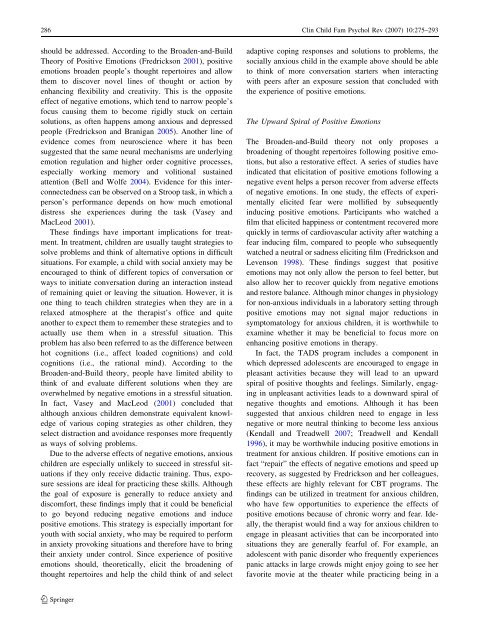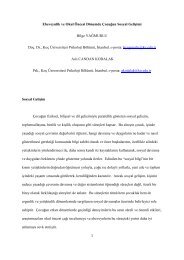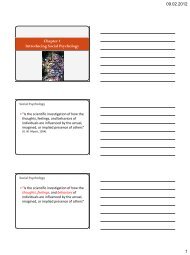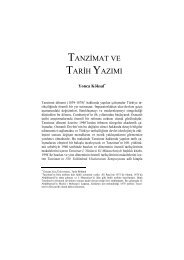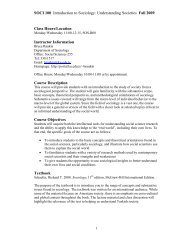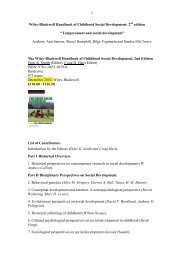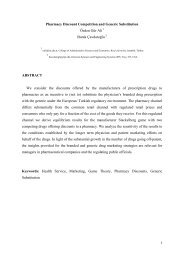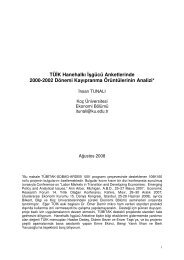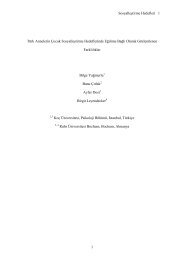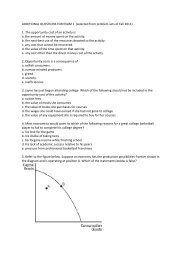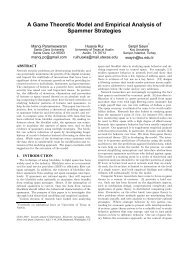The Role of Emotion Regulation in the Treatment of Child Anxiety ...
The Role of Emotion Regulation in the Treatment of Child Anxiety ...
The Role of Emotion Regulation in the Treatment of Child Anxiety ...
Create successful ePaper yourself
Turn your PDF publications into a flip-book with our unique Google optimized e-Paper software.
286 Cl<strong>in</strong> <strong>Child</strong> Fam Psychol Rev (2007) 10:275–293<br />
should be addressed. Accord<strong>in</strong>g to <strong>the</strong> Broaden-and-Build<br />
<strong>The</strong>ory <strong>of</strong> Positive <strong>Emotion</strong>s (Fredrickson 2001), positive<br />
emotions broaden people’s thought repertoires and allow<br />
<strong>the</strong>m to discover novel l<strong>in</strong>es <strong>of</strong> thought or action by<br />
enhanc<strong>in</strong>g flexibility and creativity. This is <strong>the</strong> opposite<br />
effect <strong>of</strong> negative emotions, which tend to narrow people’s<br />
focus caus<strong>in</strong>g <strong>the</strong>m to become rigidly stuck on certa<strong>in</strong><br />
solutions, as <strong>of</strong>ten happens among anxious and depressed<br />
people (Fredrickson and Branigan 2005). Ano<strong>the</strong>r l<strong>in</strong>e <strong>of</strong><br />
evidence comes from neuroscience where it has been<br />
suggested that <strong>the</strong> same neural mechanisms are underly<strong>in</strong>g<br />
emotion regulation and higher order cognitive processes,<br />
especially work<strong>in</strong>g memory and volitional susta<strong>in</strong>ed<br />
attention (Bell and Wolfe 2004). Evidence for this <strong>in</strong>terconnectedness<br />
can be observed on a Stroop task, <strong>in</strong> which a<br />
person’s performance depends on how much emotional<br />
distress she experiences dur<strong>in</strong>g <strong>the</strong> task (Vasey and<br />
MacLeod 2001).<br />
<strong>The</strong>se f<strong>in</strong>d<strong>in</strong>gs have important implications for treatment.<br />
In treatment, children are usually taught strategies to<br />
solve problems and th<strong>in</strong>k <strong>of</strong> alternative options <strong>in</strong> difficult<br />
situations. For example, a child with social anxiety may be<br />
encouraged to th<strong>in</strong>k <strong>of</strong> different topics <strong>of</strong> conversation or<br />
ways to <strong>in</strong>itiate conversation dur<strong>in</strong>g an <strong>in</strong>teraction <strong>in</strong>stead<br />
<strong>of</strong> rema<strong>in</strong><strong>in</strong>g quiet or leav<strong>in</strong>g <strong>the</strong> situation. However, it is<br />
one th<strong>in</strong>g to teach children strategies when <strong>the</strong>y are <strong>in</strong> a<br />
relaxed atmosphere at <strong>the</strong> <strong>the</strong>rapist’s <strong>of</strong>fice and quite<br />
ano<strong>the</strong>r to expect <strong>the</strong>m to remember <strong>the</strong>se strategies and to<br />
actually use <strong>the</strong>m when <strong>in</strong> a stressful situation. This<br />
problem has also been referred to as <strong>the</strong> difference between<br />
hot cognitions (i.e., affect loaded cognitions) and cold<br />
cognitions (i.e., <strong>the</strong> rational m<strong>in</strong>d). Accord<strong>in</strong>g to <strong>the</strong><br />
Broaden-and-Build <strong>the</strong>ory, people have limited ability to<br />
th<strong>in</strong>k <strong>of</strong> and evaluate different solutions when <strong>the</strong>y are<br />
overwhelmed by negative emotions <strong>in</strong> a stressful situation.<br />
In fact, Vasey and MacLeod (2001) concluded that<br />
although anxious children demonstrate equivalent knowledge<br />
<strong>of</strong> various cop<strong>in</strong>g strategies as o<strong>the</strong>r children, <strong>the</strong>y<br />
select distraction and avoidance responses more frequently<br />
as ways <strong>of</strong> solv<strong>in</strong>g problems.<br />
Due to <strong>the</strong> adverse effects <strong>of</strong> negative emotions, anxious<br />
children are especially unlikely to succeed <strong>in</strong> stressful situations<br />
if <strong>the</strong>y only receive didactic tra<strong>in</strong><strong>in</strong>g. Thus, exposure<br />
sessions are ideal for practic<strong>in</strong>g <strong>the</strong>se skills. Although<br />
<strong>the</strong> goal <strong>of</strong> exposure is generally to reduce anxiety and<br />
discomfort, <strong>the</strong>se f<strong>in</strong>d<strong>in</strong>gs imply that it could be beneficial<br />
to go beyond reduc<strong>in</strong>g negative emotions and <strong>in</strong>duce<br />
positive emotions. This strategy is especially important for<br />
youth with social anxiety, who may be required to perform<br />
<strong>in</strong> anxiety provok<strong>in</strong>g situations and <strong>the</strong>refore have to br<strong>in</strong>g<br />
<strong>the</strong>ir anxiety under control. S<strong>in</strong>ce experience <strong>of</strong> positive<br />
emotions should, <strong>the</strong>oretically, elicit <strong>the</strong> broaden<strong>in</strong>g <strong>of</strong><br />
thought repertoires and help <strong>the</strong> child th<strong>in</strong>k <strong>of</strong> and select<br />
adaptive cop<strong>in</strong>g responses and solutions to problems, <strong>the</strong><br />
socially anxious child <strong>in</strong> <strong>the</strong> example above should be able<br />
to th<strong>in</strong>k <strong>of</strong> more conversation starters when <strong>in</strong>teract<strong>in</strong>g<br />
with peers after an exposure session that concluded with<br />
<strong>the</strong> experience <strong>of</strong> positive emotions.<br />
<strong>The</strong> Upward Spiral <strong>of</strong> Positive <strong>Emotion</strong>s<br />
<strong>The</strong> Broaden-and-Build <strong>the</strong>ory not only proposes a<br />
broaden<strong>in</strong>g <strong>of</strong> thought repertoires follow<strong>in</strong>g positive emotions,<br />
but also a restorative effect. A series <strong>of</strong> studies have<br />
<strong>in</strong>dicated that elicitation <strong>of</strong> positive emotions follow<strong>in</strong>g a<br />
negative event helps a person recover from adverse effects<br />
<strong>of</strong> negative emotions. In one study, <strong>the</strong> effects <strong>of</strong> experimentally<br />
elicited fear were mollified by subsequently<br />
<strong>in</strong>duc<strong>in</strong>g positive emotions. Participants who watched a<br />
film that elicited happ<strong>in</strong>ess or contentment recovered more<br />
quickly <strong>in</strong> terms <strong>of</strong> cardiovascular activity after watch<strong>in</strong>g a<br />
fear <strong>in</strong>duc<strong>in</strong>g film, compared to people who subsequently<br />
watched a neutral or sadness elicit<strong>in</strong>g film (Fredrickson and<br />
Levenson 1998). <strong>The</strong>se f<strong>in</strong>d<strong>in</strong>gs suggest that positive<br />
emotions may not only allow <strong>the</strong> person to feel better, but<br />
also allow her to recover quickly from negative emotions<br />
and restore balance. Although m<strong>in</strong>or changes <strong>in</strong> physiology<br />
for non-anxious <strong>in</strong>dividuals <strong>in</strong> a laboratory sett<strong>in</strong>g through<br />
positive emotions may not signal major reductions <strong>in</strong><br />
symptomatology for anxious children, it is worthwhile to<br />
exam<strong>in</strong>e whe<strong>the</strong>r it may be beneficial to focus more on<br />
enhanc<strong>in</strong>g positive emotions <strong>in</strong> <strong>the</strong>rapy.<br />
In fact, <strong>the</strong> TADS program <strong>in</strong>cludes a component <strong>in</strong><br />
which depressed adolescents are encouraged to engage <strong>in</strong><br />
pleasant activities because <strong>the</strong>y will lead to an upward<br />
spiral <strong>of</strong> positive thoughts and feel<strong>in</strong>gs. Similarly, engag<strong>in</strong>g<br />
<strong>in</strong> unpleasant activities leads to a downward spiral <strong>of</strong><br />
negative thoughts and emotions. Although it has been<br />
suggested that anxious children need to engage <strong>in</strong> less<br />
negative or more neutral th<strong>in</strong>k<strong>in</strong>g to become less anxious<br />
(Kendall and Treadwell 2007; Treadwell and Kendall<br />
1996), it may be worthwhile <strong>in</strong>duc<strong>in</strong>g positive emotions <strong>in</strong><br />
treatment for anxious children. If positive emotions can <strong>in</strong><br />
fact “repair” <strong>the</strong> effects <strong>of</strong> negative emotions and speed up<br />
recovery, as suggested by Fredrickson and her colleagues,<br />
<strong>the</strong>se effects are highly relevant for CBT programs. <strong>The</strong><br />
f<strong>in</strong>d<strong>in</strong>gs can be utilized <strong>in</strong> treatment for anxious children,<br />
who have few opportunities to experience <strong>the</strong> effects <strong>of</strong><br />
positive emotions because <strong>of</strong> chronic worry and fear. Ideally,<br />
<strong>the</strong> <strong>the</strong>rapist would f<strong>in</strong>d a way for anxious children to<br />
engage <strong>in</strong> pleasant activities that can be <strong>in</strong>corporated <strong>in</strong>to<br />
situations <strong>the</strong>y are generally fearful <strong>of</strong>. For example, an<br />
adolescent with panic disorder who frequently experiences<br />
panic attacks <strong>in</strong> large crowds might enjoy go<strong>in</strong>g to see her<br />
favorite movie at <strong>the</strong> <strong>the</strong>ater while practic<strong>in</strong>g be<strong>in</strong>g <strong>in</strong> a<br />
123


